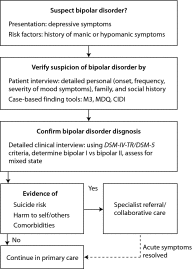The diagnosis and treatment of bipolar disorder: decision-making in primary care
- PMID: 25317368
- PMCID: PMC4195640
- DOI: 10.4088/PCC.13r01609
The diagnosis and treatment of bipolar disorder: decision-making in primary care
Abstract
Bipolar disorder is a chronic episodic illness, characterized by recurrent episodes of manic or depressive symptoms. Patients with bipolar disorder frequently present first to primary care, but the diversity of the potential symptoms and a low index of suspicion among physicians can lead to misdiagnosis in many patients. Frequently, co-occurring psychiatric and medical conditions further complicate the differential diagnosis. A thorough diagnostic evaluation at clinical interview, combined with supportive case-finding tools, is essential to reach an accurate diagnosis. When treating bipolar patients, the primary care physician has an integral role in coordinating the multidisciplinary network. Pharmacologic treatment underpins both short- and long-term management of bipolar disorder. Maintenance treatment to prevent relapse is frequently founded on the same pharmacologic approaches that were effective in treating the acute symptoms. Regardless of the treatment approach that is selected, monitoring over the long term is essential to ensure continued symptom relief, functioning, safety, adherence, and general medical health. This article describes key decision-making steps in the management of bipolar disorder from the primary care perspective: from initial clinical suspicion to confirmation of the diagnosis to decision-making in acute and longer-term management and the importance of patient monitoring.
Figures
Similar articles
-
[Antipsychotics in bipolar disorders].Encephale. 2004 Sep-Oct;30(5):417-24. doi: 10.1016/s0013-7006(04)95456-5. Encephale. 2004. PMID: 15627046 Review. French.
-
ECNP consensus meeting. Bipolar depression. Nice, March 2007.Eur Neuropsychopharmacol. 2008 Jul;18(7):535-49. doi: 10.1016/j.euroneuro.2008.03.003. Epub 2008 May 23. Eur Neuropsychopharmacol. 2008. PMID: 18501566 Review.
-
Letter to the Editor: CONVERGENCES AND DIVERGENCES IN THE ICD-11 VS. DSM-5 CLASSIFICATION OF MOOD DISORDERS.Turk Psikiyatri Derg. 2021;32(4):293-295. doi: 10.5080/u26899. Turk Psikiyatri Derg. 2021. PMID: 34964106 English, Turkish.
-
A clinical review of aripiprazole in bipolar depression and maintenance therapy of bipolar disorder.J Affect Disord. 2011 Jan;128 Suppl 1:S21-8. doi: 10.1016/S0165-0327(11)70005-2. J Affect Disord. 2011. PMID: 21220077 Review.
-
A pilot study differentiating recurrent major depression from bipolar disorder cycling on the depressive pole.Neuropsychiatr Dis Treat. 2010 Nov 9;6:741-7. doi: 10.2147/NDT.S14353. Neuropsychiatr Dis Treat. 2010. Retraction in: Neuropsychiatr Dis Treat. 2020 Dec 16;16:3129. doi: 10.2147/NDT.S296320. PMID: 21173882 Free PMC article. Retracted.
Cited by
-
Ketogenic Diet and Inflammation: Implications for Mood and Anxiety Disorders.Adv Exp Med Biol. 2023;1411:537-554. doi: 10.1007/978-981-19-7376-5_23. Adv Exp Med Biol. 2023. PMID: 36949325 Review.
-
Barriers to timely identification of bipolar disorder in youth: a multidimensional perspective.Front Child Adolesc Psychiatry. 2023 May 15;2:1186722. doi: 10.3389/frcha.2023.1186722. eCollection 2023. Front Child Adolesc Psychiatry. 2023. PMID: 39816878 Free PMC article.
-
Am I Really Bipolar? Personal Accounts of the Experience of Being Diagnosed With Bipolar II Disorder.Front Psychol. 2020 Sep 30;11:482715. doi: 10.3389/fpsyg.2020.482715. eCollection 2020. Front Psychol. 2020. PMID: 33101109 Free PMC article.
-
Major depression in primary care: making the diagnosis.Singapore Med J. 2016 Nov;57(11):591-597. doi: 10.11622/smedj.2016174. Singapore Med J. 2016. PMID: 27872937 Free PMC article.
-
Colour discrimination thresholds in type 1 Bipolar Disorder: a pilot study.Sci Rep. 2017 Nov 27;7(1):16405. doi: 10.1038/s41598-017-16752-0. Sci Rep. 2017. PMID: 29180712 Free PMC article.
References
-
- Price AL, Marzani-Nissen GR. Bipolar disorders: a review. Am Fam Physician. 2012;85(5):483–493. - PubMed
-
- Judd LL, Akiskal HS, Schettler PJ, et al. Psychosocial disability in the course of bipolar I and II disorders: a prospective, comparative, longitudinal study. Arch Gen Psychiatry. 2005;62(12):1322–1330. - PubMed
-
- American Psychiatric Association. Diagnostic and Statistical Manual of Mental Disorders. Fifth Edition. Washington, DC: American Psychiatric Association; 2013.
LinkOut - more resources
Full Text Sources
Other Literature Sources


